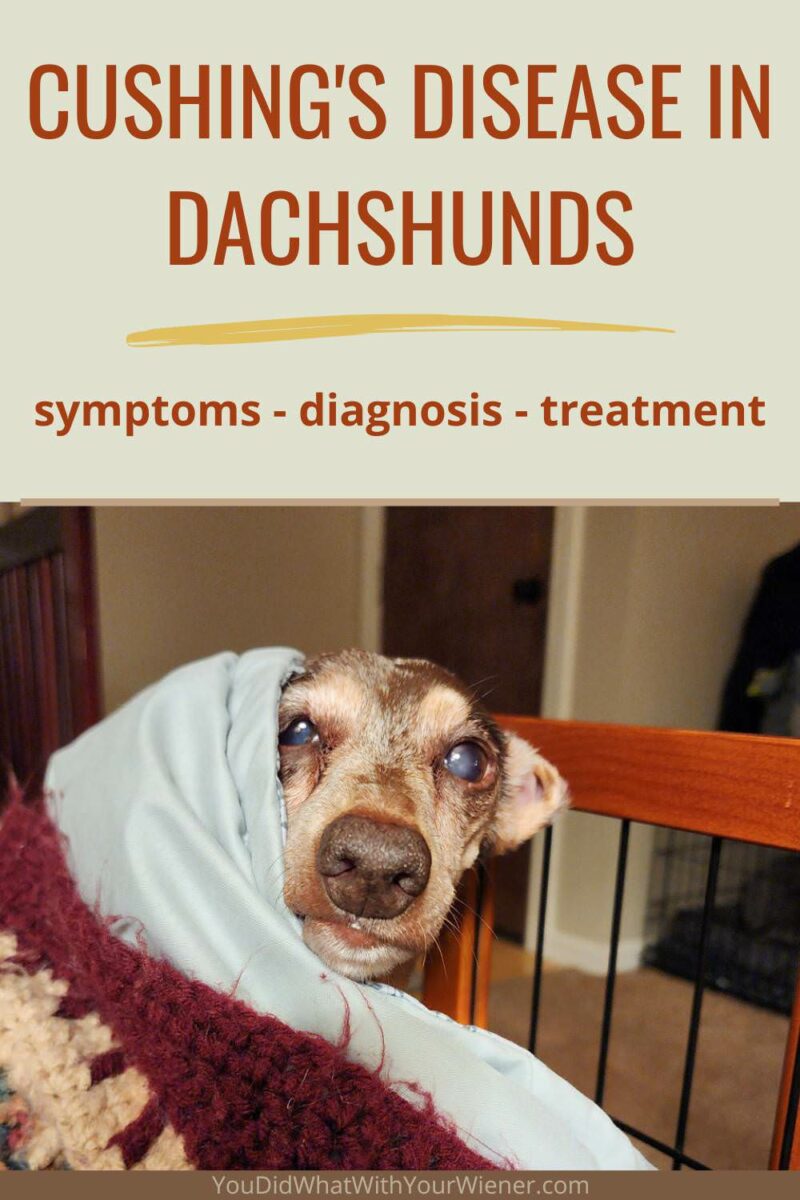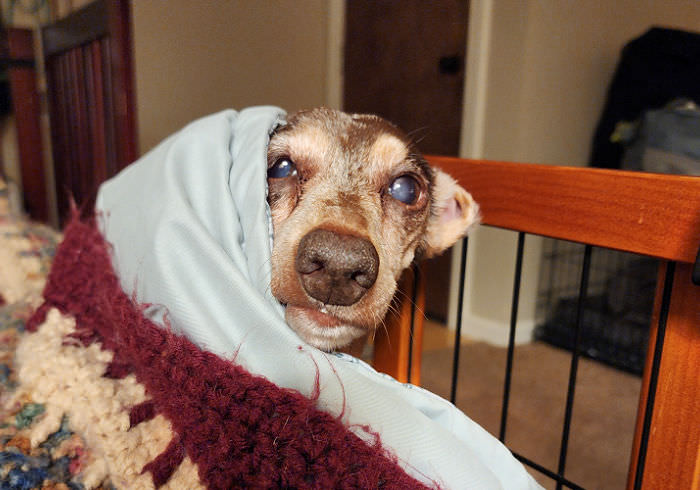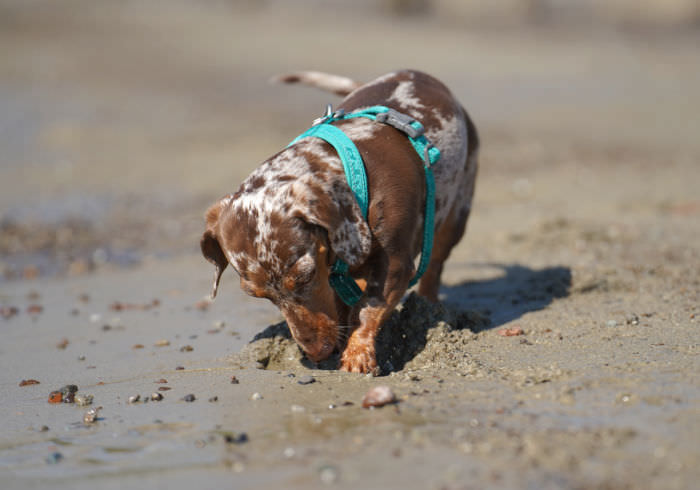If your Dachshund’s veterinarian has recently mentioned Cushing’s Disease and you aren’t quite sure what it means, it could be frightening.
No one wants to be left confused and wondering about a potential health problem with their dog.
I’ve been studying the breed full time since 2012, and Cushing’s Disease is one of the top 5 health issues I see in Dachshunds.
When I was a dog walker, one of the Dachshunds I used to spend time with had the disease, so I know a little about what’s involved in the care of a dog with Cushing’s.

Since I want to help educate Dachshund owners about the disease, and I want you to be informed if your Dachshund receives the diagnosis, I wrote this article for you.
Read on to discover the basics of Cushing’s Disease in Dachshunds, including what warning signs you should be looking for, how it is diagnosed, and what you can do to help your Dachshund manage the condition after a diagnosis.
The first thing to know is that the two primary causes of Cushing’s Disease affect cortisol levels in dogs.
The Importance of Cortisol in Dachshunds
What is cortisol, and why is it important for your Dachshund?
Cortisol is a natural steroid that is produced by the adrenal glands.
Also known as “the stress hormone,” cortisol helps prepare the body to cope with high physical or emotional stress by triggering the natural flight-or-fight response.
But that’s not its only function.
- Cortisol is also responsible for the following:
- Suppressing inflammation
- Helping with wound healing
- Regulating and controlling body weight
- Controlling the sleep-wake cycle
- Regulating blood pressure
- Maintaining normal blood sugar (glucose) levels
- Supporting muscle and ligament health
- Controlling the metabolism
As important as cortisol is for your Dachshund’s health and well-being, too much cortisol can lead to health problems.
What is Cushing’s Disease in Dachshunds?
The pituitary gland, located at the base of the brain, produces adrenocorticotrophic hormone (ACTH). This hormone tells the adrenal gland, on top of the kidneys, to produce cortisol.
Too much cortisol is produced when something goes wrong in the pituitary or adrenal glands.
This condition is known as Hyperadrenocorticism, Cushing’s Syndrome, or Cushing’s Disease.
There are two types of Cushing’s in Dachshunds.
Pituitary-Dependent
This is the most common form of Cushing’s Disease, affecting approximately 80{a47be734f0df8d7f120a7df290cf380c79376e8356d1aab405383bb23aa6ce67}-85{a47be734f0df8d7f120a7df290cf380c79376e8356d1aab405383bb23aa6ce67} of dogs.
It occurs when a tumor triggers the overproduction of cortisol or enlargement of the pituitary gland.
Adrenal-Dependent
The other 15{a47be734f0df8d7f120a7df290cf380c79376e8356d1aab405383bb23aa6ce67}-20{a47be734f0df8d7f120a7df290cf380c79376e8356d1aab405383bb23aa6ce67} of cases are caused by a tumor in one or both adrenal glands (that sit on top of the kidneys).
Approximately 50{a47be734f0df8d7f120a7df290cf380c79376e8356d1aab405383bb23aa6ce67} of these cases will metastasize (spread to other areas of the body).
A Third Type of Cushing’s Disease in Dachshunds
While there are only two naturally occurring types of Cushing’s Disease, there is technically a third type called “iatrogenic” Cushing’s Disease.
This happens when a dog receives high doses of steroids over an extended period.
The good news for Dachshunds diagnosed with “iatrogenic” Cushing’s Disease is that the symptoms will disappear when the responsible steroids are discontinued.
But it’s dangerous to stop any steroid too quickly. Instead, they should be weaned off gradually over several weeks under the supervision of your vet.
Is Your Dachshund at Risk for Developing Cushing’s?
The prevalence of Cushing’s in Dachshunds made me curious what influences the development of the disease.
Besides breed, risk factors include:
- Gender – While I found some conflicting information, generally, females are more likely to develop Cushing’s disease than males.
- Obesity – Overweight dogs are more likely to develop Cushing’s disease than dogs that maintain a healthy weight.
- Steroid medication – Dogs that are on long-term steroid medication for other conditions are at an increased risk of developing Cushing’s disease.
- Other health conditions – Dogs with certain health conditions, such as diabetes and hypothyroidism, may have an increased risk of developing Cushing’s disease.
- Genetics – In some cases, Cushing’s disease may be hereditary, meaning that dogs with a family history of the condition may be more likely to develop it.
The fact that Cushing’s Disease is more common in Dachshunds isn’t a reason to panic.
It doesn’t mean that your Dachshund is guaranteed to be diagnosed or that any drastic steps must be taken to keep them safe.
But it’s important to focus on living a healthy lifestyle with your dog and to learn the signs of Cushing’s Disease so you can look out for them.
Signs and Symptoms of Cushing’s Disease in Dachshunds
Cushing’s Disease can be hard to spot initially as it comes on incredibly slowly and the early signs are often overlooked because of this.
Minute, incremental changes can be difficult to notice when you see your Dachshund every day.
Recognizing the disease is made even more challenging by the fact that most symptoms can be explained away as part of the natural aging process.
Drinking and peeing more frequently are usually the first symptoms.
Other common symptoms include:
- Potbelly/abdominal swelling
- Fat accumulation on the neck and shoulders
- Housebroken dogs may start to have accidents
- Bladder or kidney infections
- Susceptible to blood clots
If you recognize any of these signs, make an appointment with your veterinarian.
The sooner Cushing’s Disease is diagnosed, the better the chances are that it can be managed or treated effectively.
How is Cushing’s in Dachshunds Diagnosed?
The process of diagnosing Cushing’s Disease can be difficult as the symptoms are often relatively mild and can be attributed to several other health conditions, including natural aging.
To help your veterinarian with the process of finding a diagnosis, make any physical changes or new behaviors that you’ve noticed.
They will likely start with blood and urine tests to check for Cushing’s and rule out other possible health problems.
Your veterinarian may also do an ultrasound to check for a tumor on the pituitary gland or the adrenal glands.
One of the most effective ways to diagnose Cushing’s Disease in Dachshunds is with the use of magnetic resonance imaging (MRI) to check the adrenal glands.
But MRI testing is expensive, so it’s not always an option for owners.
Below are more details about the ways in which your veterinarian may test your Dachshund for Cushing’s Disease.
Urine Cortisol – Creatinine Ratio
To start the process of diagnosing your Dachshund, your veterinarian will test their urine for the cortisol – creatinine ratio.
If this is high, it’s a sign that it could be Cushing’s, and further testing is needed.
Alkaline Phosphatase Level
A test may be done on your Dachshund’s blood to measure the level of the liver enzyme alkaline phosphatase.
If that level is high, that is also a sign that further testing should be done.
Low-Dose Dexamethasone Suppression Test (LDDST)
The most common test used to diagnose Cushing’s in Dachshunds – the low-dose dexamethasone suppression test – involves measuring the body’s reaction to the presence of cortisol by using a man-made version called dexamethasone.
To begin, a blood sample is taken to measure the baseline cortisol level.
Dexamethasone is then injected into your Dachshund.
In a healthy dog, the pituitary gland will sense the higher cortisol level and tell the adrenal gland to stop producing more, allowing that level to plateau and eventually start to drop again.
After 4 to 8 hours, a second blood sample is taken.
This will be tested, and the cortisone levels will be compared to the baseline.
If the cortisone levels decrease, that is a sign that everything is functioning appropriately.
But, if the cortisone levels remain high or even increase, something isn’t working as it should.
This could mean that the pituitary gland isn’t responding correctly to the higher cortisone level or that the adrenal gland continued to produce cortisol.
Both conclusions are a warning that your Dachshund may have Cushing’s.
High-Dose Dexamethasone Suppression Test
This test is the same as the low-dose test I just described, except that a higher dose of dexamethasone is given.
Adrenocorticotropic Hormone (ACTH) Stimulation Test
This test is similar to the LDDST in that a blood sample is taken to measure a baseline.
But this time, the sample is testing the level of ACTH.
After a shot of the hormone is given, a second blood sample is taken.
The two results are compared to see how your Dachshund’s body is responding to the hormone.
Treatment for Cushing’s Disease in Dachshunds
If your Dachshund has been diagnosed with Cushing’s Disease, I am sure you are wondering “What’s next?”
If your dog has iatrogenic Cushing’s, the disease was caused by steroid use.
This means that treatment will involve slowly tapering down the steroids that your Dachshund takes following a withdrawal schedule set by your veterinarian.
As they reduce and discontinue steroid use, the symptoms will stop.
Of course, taking your Dachshund off their steroids may mean that the original condition you were treating will return, so should have a conversation with your vet about other options.
If your Dachshund has Cushing’s Disease because of a tumor, it may be able to be treated with surgery. But removing the tumor isn’t always possible.
It may be a complicated removal that could lead to other issues, or it could have already spread to other areas of the body.
The only drug the FDA has approved for the treatment of both pituitary and adrenal-dependint Cushing’s Disease in dogs is Vetoryl (trilostane).
Vetoryl works by stopping the adrenal glands from producing cortisol, effectively lowering the cortisol levels in your Dachshund’s body.
But this means that it’s not safe for all dogs.
It should not be given to Dachshunds that are pregnant, have kidney or liver disease, or take certain medications for heart disease that could have a negative interaction.
- According to the package insert, possible side effects of Vetoryl use in dogs include:
- Poor or reduced appetite
- Diarrhea (sometimes bloody)
- Sodium/potassium imbalance
- Elevated liver enzymes or kidney tests
In rare cases, the use of Vetoryl can have fatal consequences.
There is one other drug that has FDA approval, but it is only approved for the treatment of pituitary-dependent Cushing’s disease and only in straightforward, uncomplicated cases.
That is Anipryl (selegiline).
Finally, some vets will use the human chemotherapy drug Lysodren (mitotane) “off-label.”
The tern “off label” means that they can legally use it but are not using it for the intention listed on the drug’s label.
This drug works in the treatment of Cushing’s in Dachshunds by eroding layers of the adrenal gland, preventing it from being able to produce cortisol.
But you should keep in mind that this drug was created for use in humans as part of chemotherapy treatment.
This means that your Dachshund may experience unpredicted side effects or reactions.
Natural Remedies for Cushing’s Disease in Dachshunds
If you aren’t comfortable with these medical treatment options, you may be interested in exploring natural or alternative treatment options.
But these treatments should still be done under veterinary supervision.
This means either working with your current veterinarian, if they are open to alternative medicine, or connecting with a holistic vet.
The two most common natural remedies for Cushing’s in dogs are melatonin and HMR lignans/flaxseed lignans.
These treatments are lower cost than conventional medications.
They are also gentler on your Dachshund.
This makes natural remedies a popular choice for seniors or aging dogs and dogs that often experience serious side effects or problems with medications.
Natural remedies won’t work to make a tumor disappear, but they can help to manage the symptoms, thus improving your Dachshund’s quality of life.
Melatonin
A natural hormone that is produced in the body, Melatonin plays an essential role in the sleep-wake cycle and is often used to help with sleep-related problems.
It has also been found to suppress two enzymes that are necessary to produce cortisol, slowing production.
For treatment to be effective, the level of melatonin in your Dachshund’s system will have to be kept consistent through regular doses.
HMR Lignans/Flaxseed Lignans
Lignans also suppress two enzymes needed for cortisol production.
They also help to restore your dog’s energy levels, encourage a healthy weight and appetite, and improve healthy hair growth.
HMR lignans are derived from the Norway spruce tree, while flaxseed lignans come from the hard outer hull of flaxseeds.
What is the Prognosis for Dachshunds with Cushing’s Disease?
The prognosis for Dachshunds with Cushing’s Disease will depend on several factors.
Some dogs will respond very well to treatment.
This, coupled with being healthy otherwise, may allow your Dachshund to live a long, happy life.
But there is also a risk that your Dachshund may have a more complicated case or that the tumor responsible for the condition has spread, leading to other health issues.
I recommend having a conversation with your veterinarian. Don’t be afraid to ask questions to ensure you fully understand the potential outcomes.
How to Live with a Dachshund that has Cushing’s Disease
The most important thing you can do for your Dachshund if they have been diagnosed with Cushing’s Disease is to follow the treatment plan laid out by your veterinarian.
This may include medications, dietary changes, or adjustments to your lifestyle.
Try to provide a comfortable, quiet, and low-stress home environment.
Make sure to stay on top of regular appointments with your vet.
This will allow them to keep tabs on your Dachshund’s progress and change the treatment plan if needed.
Pay attention to any signs that the current treatment plan isn’t working, like worsening symptoms.
You should also watch out for adverse reactions to your Dachshund’s medications, including nausea, vomiting, diarrhea, loss of appetite or lethargy.
Final Thoughts
While I can’t say whether the frequency is on par with other dog breeds since I am only focused on Dachshunds, I can say that Cushing’s Disease is a common health issue among doxies.
Watch for the signs of Cushing’s in your dog, especially as they get older, but know that many of the signs and symptoms could also indicate something else is wrong.
They can also be subtle and slow – so slow that they may be difficult to detect.
But if you have any concerns at all, contact your vet and discuss Cushing’s with them.
Catching the disease early will give your Dachshund the best chance at enjoying a long, healthy life.




